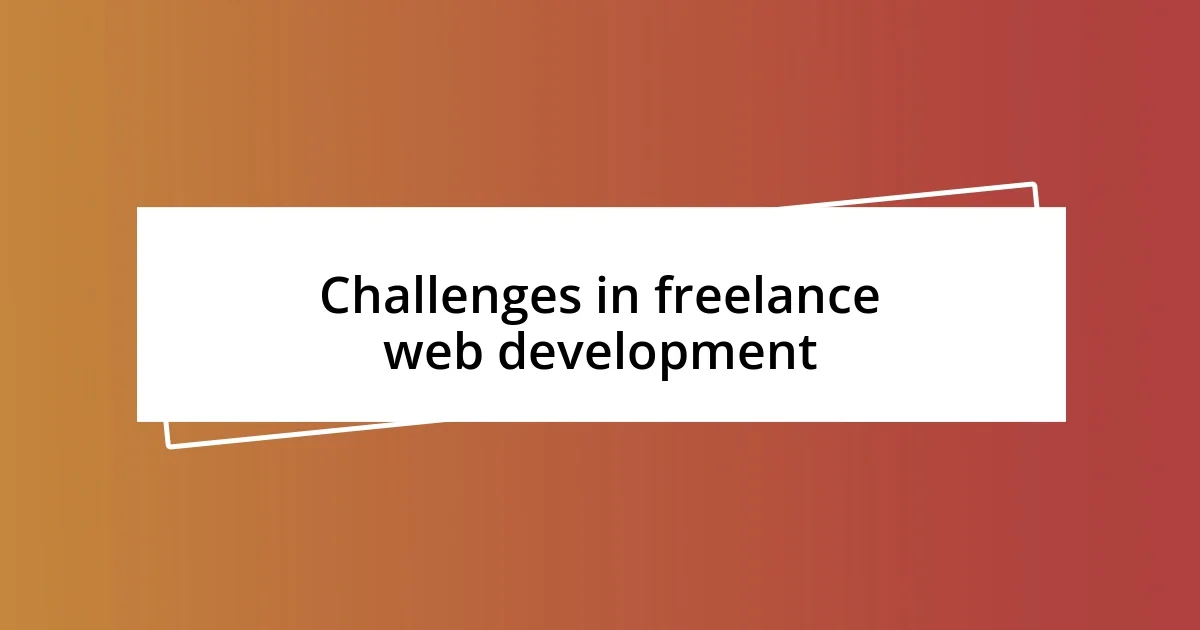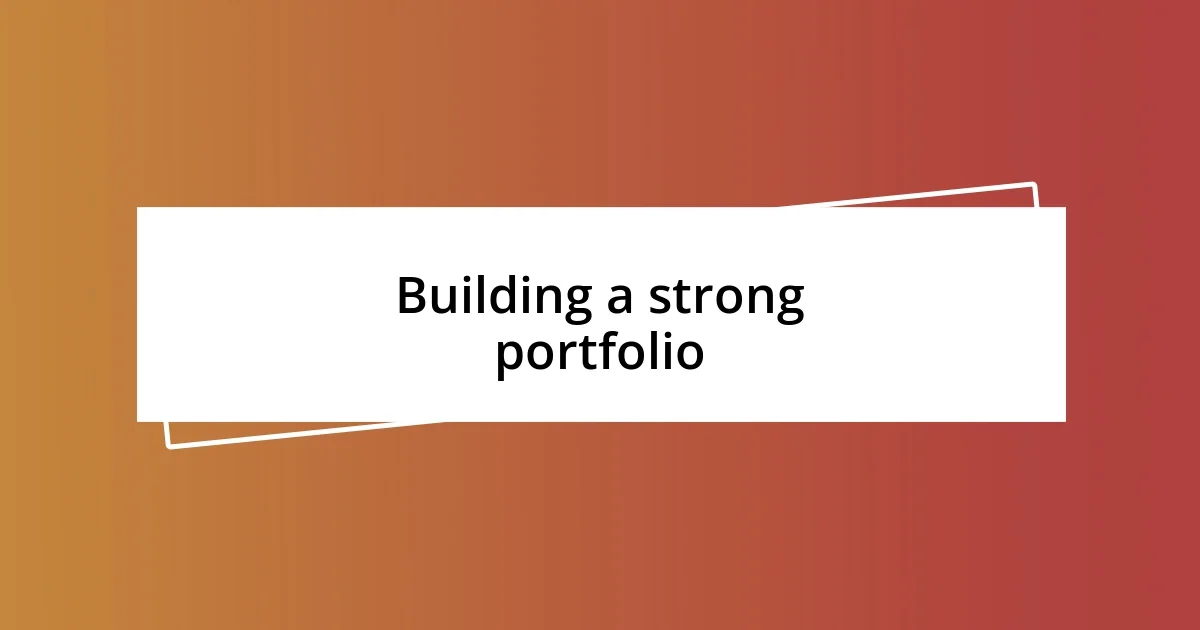Key takeaways:
- Freelance web development offers flexibility and personal project choice but requires strong self-discipline and time management skills.
- Building a strong portfolio and effective client attraction strategies are essential for showcasing skills and growing freelance opportunities.
- Setting appropriate rates and embracing flexibility in project management can enhance sustainability and strengthen client relationships.

Introduction to freelance web development
Freelance web development is an exciting career option that combines creativity with technology, allowing individuals to craft unique online experiences. I remember the first time I landed a project; it was a rush of adrenaline mixed with a little anxiety. It’s exhilarating to realize that you have the power to build websites from scratch—do you ever wonder what it feels like to bring someone’s vision to life?
As I embarked on my freelance journey, I quickly discovered that the freedom of choosing my projects came with the challenge of self-discipline. One late night coding session, fueled by coffee and a looming deadline, taught me to balance my passion with responsibility. Have you thought about the discipline required when the comforts of a traditional 9-to-5 job aren’t there to structure your day?
Every project offers a new opportunity, and the diverse range of clients keeps things fresh and exciting. I’ve felt the pride of working with small startups, helping them establish their online presence, and it’s incredibly rewarding to watch their growth. Can you imagine the satisfaction of seeing your work not just as code, but as a stepping stone for someone else’s success?

Benefits of freelance web development
Freelancing in web development offers unparalleled flexibility that really reshapes how I approach my work-life balance. I find that I can choose my hours and work from anywhere—whether it’s a cozy coffee shop or the comfort of my home office. It gives me the chance to structure my day around my personal peak productivity times, allowing for bursts of creativity that traditional jobs often stifle. Imagine stepping away from a project to grab a quick jog and coming back feeling rejuvenated and ready to tackle the next challenge!
Here are some benefits I’ve experienced:
- Choice of Projects: I can select clients and projects that truly resonate with my interests.
- Control Over Income: With the ability to set my rates, my earnings directly reflect my effort and skill level.
- Variety of Work: Constantly engaging with different technologies and industries keeps my skills sharp and diverse.
- Personal Growth: Each completed project adds to my toolkit, building confidence with every success.
- Work-Life Harmony: I can prioritize personal commitments without the constraints of a rigid work schedule.
This aspect of freelancing has made my professional life feel more like an adventure than a grind. Being able to pivot into projects that intrigue me keeps the passion alive and the work exceptionally rewarding. It’s hard not to appreciate that freedom when I can wake up, enjoy a leisurely breakfast, and dive right into code that excites me!

Challenges in freelance web development
The challenge of managing time effectively in freelance web development is something that continually tests my resolve. When I first started, I underestimated how crucial time management would be to meet client deadlines. I’ve been in situations where I promised too much, leading to sleepless nights just to deliver on time. Have you ever found yourself in a similar position, racing against the clock?
Another significant hurdle I’ve faced is dealing with inconsistent income. Unlike a steady paycheck from a traditional job, freelance income can swing like a pendulum. There have been months where I felt like I hit the jackpot and others where I had to tighten my belt. Understanding how to budget and plan for lean periods became essential. Have you ever planned a big purchase and then had to reconsider because of a slow client month?
Communication can often be a double-edged sword in this profession. Clarifying my vision with clients, especially those less technical, can be challenging. I once worked with a client who wanted a vibrant, interactive site but had very little understanding of what that required. A few miscommunications left me feeling frustrated and the client feeling overwhelmed. How do you approach these conversations to bridge the gap between expectation and reality?
| Challenges | Description |
|---|---|
| Time Management | Balancing project deadlines with personal time can be a daunting task. |
| Income Instability | Freelancing often leads to unpredictable income, requiring careful budgeting. |
| Communication Issues | Clarifying client expectations can lead to misunderstandings without proper dialogue. |

Building a strong portfolio
Building a strong portfolio is crucial in showcasing a freelancer’s skills and creativity. I remember when I started, I was unsure about what to include. After much thought, I realized that quality outweighed quantity; a few well-executed projects that reflect my best work resonated more than a sea of mediocre ones. Do you ever wonder which projects truly highlight your abilities?
It’s also important to tailor your portfolio to the type of clients you want to attract. I made a deliberate choice to showcase projects that aligned with my interests and the industries I wanted to work in. This not only generated more inquiries but also sparked conversations that led to exciting collaborations. Have you ever crafted your portfolio to speak directly to those ideal clients?
Finally, keep it updated and reflective of your growth. I often revisit mine to swap out older work for newer projects that demonstrate my evolving skills. This ongoing process not only keeps my portfolio fresh but also reminds me of how far I’ve come in my freelance journey. Isn’t it satisfying to see that progress reflected in your work?

Finding and attracting clients
Knowing how to find and attract clients has been a game-changer in my freelance journey. Initially, I relied on word-of-mouth and social media, but I quickly realized that a more strategic approach was necessary. One unforgettable moment was when I joined a local networking group; the connections I made not only led to projects but also friendships that enriched my professional life. Have you considered how networking could open doors for you?
Leverage online platforms to showcase your expertise and attract potential clients. When I first started using freelance job boards, I felt overwhelmed by competition. However, I learned that crafting personalized proposals that reflect an understanding of the client’s needs sets you apart. Tailoring my pitches with insights from my experiences truly resonated with clients, leading to more positive responses. What strategies do you employ to make your proposals stand out from the crowd?
A strong online presence and an engaging social media strategy can significantly boost your client interactions. I remember experimenting with sharing my ongoing projects and the thought processes behind my design choices on platforms like Instagram. This not only showcased my work but also humanized my brand, inviting conversations from prospective clients who appreciated the behind-the-scenes peek. Have you thought about how sharing your journey might resonate with your audience?

Setting your rates effectively
Setting your rates can feel like a daunting task, especially when you’re just starting as a freelancer. I remember when I first grappled with this; I thought about what others were charging and tried to fit in. However, I quickly realized that my rates should reflect my skills, experience, and the value I provide. Have you ever found yourself second-guessing your worth?
When determining your rates, it’s crucial to consider both your living expenses and the time you invest in each project. I once calculated how many hours it really took me to complete a project versus how much I was earning. The numbers didn’t add up, and I felt undervalued. It taught me that understanding my financial needs and adjusting my rates accordingly was key to sustainability. Have you taken a close look at your expenses lately?
Lastly, don’t forget the power of flexibility in your pricing strategy. In my experience, offering different packages can cater to various client needs—some may want a basic service, while others might seek a comprehensive solution. I found that by providing tiered options, I could attract a broader range of clients without compromising my value. Have you explored different pricing models to find what resonates best with your audience?

Tips for successful project management
Effective communication is a cornerstone of successful project management. I vividly recall a time when I misinterpreted a client’s requirements because I didn’t clarify specific details upfront. As a result, I spent hours creating something that wasn’t aligned with their vision. Have you ever experienced a project derailment due to unclear expectations? Since then, I prioritize regular check-ins and open discussions to ensure we’re on the same page.
Additionally, utilizing project management tools can streamline your workflow and keep everyone accountable. I remember when I started using Trello to track my progress. It was eye-opening! This simple shift allowed me to visualize my tasks and deadlines, making it easier to manage multiple projects simultaneously. What tools have you found to be game-changers in your own work?
Lastly, embrace flexibility and adaptability in your approach. There was a situation where a client requested significant changes mid-project, and instead of pushing back, I chose to pivot. By remaining open to their feedback and adjusting my plans, I not only salvaged the project but also solidified our working relationship. Have you considered how being adaptable can turn challenges into opportunities for growth?














